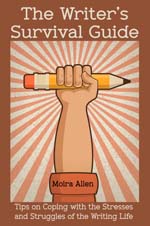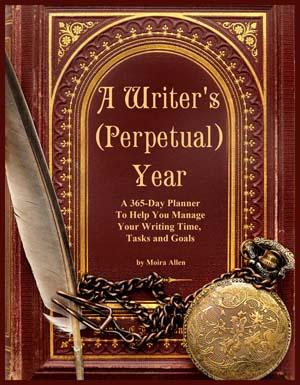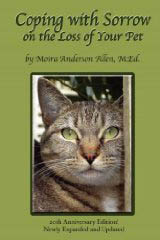 Your Guide to a Successful Writing Career
| |||
|
by Sean McLachlan
So who are midlisters? They're the serious professionals whom publishers rely on to produce good, marketable books year after year, spanning all genres from nonfiction to fantasy to romance to young adult. They've moved beyond the small press to win regular paying contracts, but they do not have bestsellers. They often work a variety of writing jobs in addition to their books, including mentoring, magazine articles, and copy editing. The reality that every aspiring author must face is that, chances are, they will not hit the bestseller lists. No matter how talented, hardworking, and prolific a writer may be, the market simply cannot sustain more than a few Stephen Kings and J.K. Rowlings. But making a living as an author is possible. Midlisters are proof of that. In-depth interviews with half a dozen midlisters reveal certain similarities in their approach to work, and provide hints at how aspiring authors can make careers that will span decades. First off, midlisters are prolific, often to an intimidating degree. They work day in and day out for years, and it adds up. Jane Toombs has published more than eighty novels, the majority of them romance, with big names such as Silhouette and Avon. Lawrence Schimel has published more than ninety books and almost two hundred short stories. Sally Odgers beats them all with about three hundred titles in virtually all genres. Once they have a bunch of titles under their belt, midlisters resell their old work. Published articles and stories can be sold as reprints, and while books that have gone out of print generally do not get bought by another major publishing house, they can find a new life with ebook and print-on-demand publishers. Lawrence Schimel is a master at recycling old short stories, often republishing them several times in magazines and anthologies. One of his short stories has been reprinted a dozen times. Reprinted articles and short stories generally earn $25-75, and electronic and POD books usually earn only in the low hundreds, but that's better than the nothing those works were earning after they had gone out of print, and often the only extra work involved is sending a few emails. Writing reams of prose isn't enough. These writers send out their work constantly and, like all professionals, midlisters deal well with rejection. Fantasy and science fiction author Judith Tarr says, "I think it helps to understand from day one that it's not personal. Rejection still hurts -- having your series dumped in midstream by a publisher that decided, quite abruptly, to change course completely can make you feel pretty awful. But it's not about you. It's business. The best thing you can do is pull up your socks, pull out the toolbox, and start putting together a new project." Sally Odgers says, "I always think thin-skinned people should not become writers. It's like constantly applying for jobs. Most people do that only now and again, but midlist authors do it for life." Sometimes they glean a bit of ironic humor from their rejections. Odgers had a teen novel rejected by a publisher who complained that "the author knows nothing about teenagers" even though Odgers was a teenager at the time! To secure a reasonably stable living, midlisters usually write in several different genres. Lawrence Schimel got started writing science fiction stories, making his first sale when he was still in high school. He used his connections with editors and writers to become an anthology editor, and then broke into the children's book market while not turning his back on writing short stories or editing anthologies. Other writers do the same. Odgers and Toombs have both published romance, fantasy, suspense, and nonfiction. One children's writer, who asked not to be named in this article, moonlights as a writer of gay erotica and, just to prove that a real writer can write anything, writes lesbian erotica under a different name! Having numerous titles across several genres means midlisters often write under a variety of pseudonyms. Sally Odgers, who writes primarily for children, says, "I've been asked to use pen names quite often, for various reasons. One editor wanted me to sound younger and prettier than I was. One wanted me to appear to be male. One wanted me to seem ethnically different from what I am. Occasionally I choose to use one, if I'm writing in a genre that is unsuitable for my main audience." Judith Tarr adds, "If the writer is very prolific in a wide range of genres and subjects, she may want to avoid saturating the market by publishing different projects under different bylines. Another common reason (and this has become more common in recent years) is that if sales are low or declining under one name, a new name allows the writer to start over with higher sales. Robin Hobb (aka Megan Lindholm) is a well-known example of this. At the moment a 'first novelist' has a better chance of getting decent sales, and improving them in subsequent books, than a known name on a downward spiral." Also, midlisters know how to change with the market. Sally Odgers says, "the fashion keeps changing, so I reinvent what I write every few years." Writing in several different genres keeps up her interest, adding variety and spice to what could easily become a creativity-killing grind. Judith Tarr is similarly flexible, starting out with science fiction and moving into historical epics and fantasy. She notes, "Classic fantasy, except for a few bestsellers, is in free fall. All the interest at the moment seems to be in urban and paranormal, and in books for younger readers. I've been aiming in the latter direction, have a middle-grade book coming out from Tor, and the current roster of projects is mostly YA and middle-grade." In the chaotic world of publishing, it isn't just the genres that keep changing, so midlisters keep track of editors as they move between publishers. Lawrence Schimel seems to know every editor and agent's CV, partially because he's been working with some of them on and off for years, even decades. When someone he worked with in one publishing house moves to another, he suddenly has an inside contact at a new potential market. Midlisters keep a close eye on market news with industry publications such as Publishers Lunch and Publishers Weekly. Schimel takes advantage of living in Madrid to hop over to the Frankfurt Book Fair every year, helping maintain his contacts and keeping up on current trends. Always on the lookout for other income possibilities, midlisters often have other writing-related jobs. Like many writers, Judith Tarr offers editing services, but other work comes her way too. "I happened across a job writing passages for a national standardized testing project, which has been beyond valuable for teaching me how to write for younger readers. I know writers who do tech writing, editing of various sorts, newspaper work, lectures and workshops, blogging, web design, and so on and on. The more skills a writer has, the better a chance she has of weathering storms in the career." Some writers, however, focus on their books alone. Dennis Mckiernan's widely successful fantasy books have put him on the high end of the midlist and free from other work obligations. Romance author Robin D. Owens' investments from her previous job give her the financial confidence to go it with books alone. The common denominator here is that midlisters are professionals. They work hard, maintain professional contacts, and keep a finger on the pulse of the industry. Perhaps most importantly, they threw away their rose-tinted glasses years ago. Dennis McKiernan says that after a few years, "I believe the writer gets to know the business better. The writer gets to know other writers, editors, agents, etc., and learns how to help others in this network of friends as well as be helped by them. I think that writers perhaps have different expectations as they get more experience. Beginning writers tend to think that there will be significant advertising and pushing of their books on the part of the publisher, but that doesn't happen unless one becomes a Stephen King or other writer in the upper stratosphere of 'bestsellingdom.' Experienced writers have come to know the business better, and their expectations more closely conform to the reality of the business." But is it worth it? After ten, fifty, a hundred books, is writing still fun? According to these battle-hardened veterans, yes. Lawrence Schimel says, "I'm able to make ends meet doing the books I'm doing and that I want to do, so I am very lucky." Sally Odgers says, "I survived the dreaded let-down that often hits people when they've been 'in' for about seven or eight years and realize they'll never be anything but a midlister. I decided long ago that a midlister was a good thing to be." Robin D. Owens turns the question around. "I always have three bottom line questions: 1) Do you feel better on a day that you've written than a day that you haven't? 2) If you knew you would never be published (or published again) would you continue to write? 3) If someone offered you $10 million to stop writing, including journaling, could you take the money and keep your word?" The right answers to these questions are obvious, and if you answered correctly, have a good work ethic and a realistic view of the publishing industry, you can join the professional, and satisfied, ranks of the midlisters.
This article originally appeared in The Writer. This article may not be reprinted without the author's written permission. Sean McLachlan worked for ten years as an archaeologist before becoming a full-time writer specializing in history and travel. He is the author of Byzantium: An Illustrated History (Hippocrene, 2004), It Happened in Missouri (TwoDot, 2007), and Moon Handbooks London (Avalon, 2007), among others. Visit him online at Visit him online at http://www.midlistwriter.blogspot.com and https://www.seanmclachlan.net/. |
| ||
| |||




